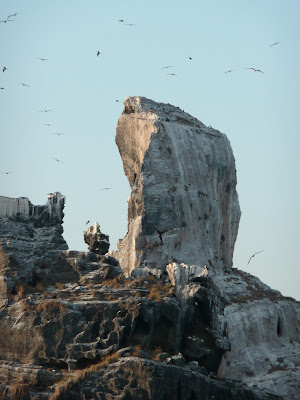 |
| The anchorage at La Cruz |
While we kept busy with boat projects in La Cruz, we were
also closely monitoring the weather and running scenarios for the trip north.
The forecast showed strong northerlies for the next 4 - 5 days. On the morning
cruiser’s net, the word from the “weather guy” was don’t head north yet.
The skies were overcast, the
mountains around the bay shrouded in mist, and the air felt ominously chilly.
All winter the winds are predominantly from the northwest, so we knew we would
most likely be beating for the 350 or so miles to La Paz – but we didn’t want
to add unusually high wind speed to the uncomfortable wind direction.
When it was finally predicted to let up, we took off. The
forecast looked decent for the next 3-4 days and that’s what we needed. A
10-hour day of motoring, with a little sail up at times to assist, had us
retracing our track from December to Matanchen Bay for a restful night in this
huge calm anchorage.
Working our way around the tuna boats, we took off in the morning.
 |
| And caught our own couple of Skip Jack Tunas. |
 |
| which are always fun to clean and fillet underway! |
 |
| Sushi for lunch -- muy elegante! |
This day’s passage had us pointing out whales to each
other until we lost count of the number. Sometimes we’d see two or three far
off and watch them breech and slap their tall dorsals. Others would silently
appear 100 feet off the bow, creating a slick on the surface of the water or
appearing to be a huge black rock slowly rising. We’d slow the engine to a
crawl and marvel as they moved off underwater again, sometimes waving with a
giant tail fin. These are humpbacks who like to do the water smacking and grey
whales, often mothers with calves in tow, nursing and teaching them to swim in
the warm waters.



The next day was a 42 nautical miles (9 hour) motor heading
windward to anchor off the highly acclaimed bird sanctuary called Isla
Isabella.
Jacques Cousteau spent
time here and National Geographic has filmed here. Currently it is a research
site for biologists from universities in Mexico City and Guadalajara to study
the life cycle and behavior of the various bird species nesting here –
predominately magnificent frigates and blue-footed boobies.
 |
| Isla Isabella looks suspiciously like a tropical iceberg. |
While the stop is
popular among cruisers and is the only anchorage on the crossing between the
Mexican Pacific Coast and the Baja Peninsula, it also carries a warning about
difficulties in anchoring. The rocks around the island provide poor holding and
lots to foul on. The books recommend a trip line to help pull your anchor
should it get wrapped around rocks. The stories of anchors needing to be cut
and left behind are disconcerting, but off you go.
We oogled and photographed from the
boat, while simultaneously discovering a small but persistent leak from the raw
water cooling pump in the engine compartment -- deep breath. We had a new spare
in the bilge and by 10 the next morning it was in place and we were back with
an engine. It’s always a little hairy to disable your engine at anchor, but
having held solidly all night we got the plumbing job done without much sense
of risk.
 |
| the hardware store |
 |
| the culprit |
 |
| the workshop |
Back on the boat in early afternoon, we motored from Isla
Isabella, with a short delay to pull in and release a large toro. The fishing
is said to be excellent off the island so we had to put in our line, hoping for
a dorado or wahoo to compliment the tuna in the freezer. We got a hit almost
right away, but knew it was a toro by the way it dove straight to the bottom.
 |
| Ugly... and bad tasting! |
Lanham got an upper body workout, taking about 20 minutes to bring it in. We
were happy to let him go. This was the fish that took a hacksaw to cut through
and tasted like liver. No more fishing this day – time to make tracks to the
northwest.
































No comments:
Post a Comment